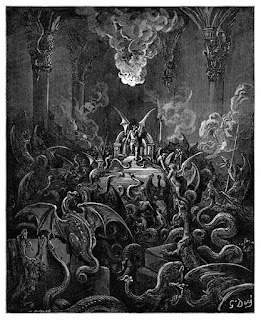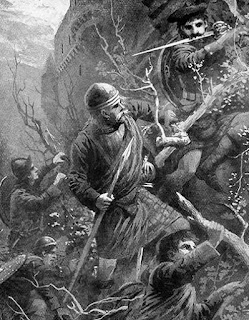Visible just below the clear waters yawns the mouth of a cavern, cut into the dark stone by ancient vulcanism and the relentless pounding of the salt. Quiet except for the waves during the day, at night, it's said that lights flash deep in the cavern's gullet and percussive shocks can be felt through the walls or seen atop the water in the lulls between the crash and flow. And at low tide, the entrance is even tall enough for a rower's boat to enter...
Glowshock Cavern - another location on my home hex map of the Caanish Archipelago and another risk for future players in posting it - herein presented (or as a PDF here) for your eager exploration. Delve on, readers!

|
|
Scale: 10 ft. |
A Watery Grotto
Glowshock Cavern is - for most of the day - entirely submerged in water. Only at the lower tides does it become accessible via boat: and as such, any adventurer going inside without a spare source of breath is on a timer as soon as they row through the cavern mouth. This is reflected in the map via three shades of the accessible portion of the cave:
- Dark blue shading indicates deeps.
- Light blue shading indicates shallows.
- Absence of shading - white floor - indicates sand.
Portions so shaded on the map are affected by the tides as follows:
| Depth | Low Tide | Transition | High Tide |
|---|---|---|---|
| Sand |
Areas noted as sand are dry ground - or, dry in that the water
line does not rise above. A character will have ability to breathe and
move. |
Water ankle deep. Visibility and movement not impacted. |
|
| Shallows |
Water knee deep. Visibility underwater is good; movement not
impacted. |
Water waist deep. Visibility still decent; walking movement reduced by
30'. |
Water neck deep. Areas surrounded by deeps are reduced to air pockets. |
| Deeps |
Water neck deep. Movement reduced to 30' unless swimming. |
Water line flush with the ceiling in all places not surrounded by
Shallows. Characters will have to swim and either hold their
breath or find an alternative source. |
|
Note, tides operate on an approximately 12 hour cycle - low tide being 12 hours distant from the next low tide, high tide being 12 hours distant from the next high tide - and as such, the day can be divided into four segments of 6 hours each: with low tide proceeding to transition, transition to high tide, high tide back to transition, and transition into low tide again. Thus, a referee should mark a counter as to which point in the cycle the adventurers arrive at the cavern and keep a strict account of turns passing - as 36 turns will pass quite rapidly as the waves slowly lap up the remaining air at the cave mouth.
A sadistic referee may opt to make the true high and low tidal periods shorter - perhaps three hours - with the net time as 9 hour segments of transition.Wandering Monsters in Glowshock Cavern
The water in Glowshock Cavern is of briny salinity - with water flowing into it from the inland aquifer mixing with the press of the ocean - making it a popular hide for oceanic creatures and a haven for lost river and delta-dwelling creatures with tolerance enough to make it this far. Wandering Monsters encountered while in Glowshock Cavern are generated with 2d6 on the following table:
| Roll | Result |
|---|---|
| 2 | 1d2 Catfish (X31) |
| 3 | 2d6 Lesser Sea Serpents (X39) |
| 4 | 1d6 Saltwater Termites (X40) |
| 5 | 2d4 Piranhas (X31) |
| 6 | 1d3 Freshwater Termites (X40) |
| 7 | 2d8 Bomber Worms (see below) |
| 8 | 1d2 Giant Crabs (X29) |
| 9 | 2d4 Rockfish (X31) |
| 10 | 1d4 Giant Leeches (X34) |
| 11 | 1d4 Giant Squid (x39) |
| 12 | 1d2 Giant Octopus (X37) |
To reinforce the theme, a referee is encouraged to roll for encounters
normally - once every other turn, with a wandering monster occurring on a 1,
as normal. However: in addition - if the referee rolls a 6 on the check, an
encounter with 1+1d6 Bomber Worms should occur.
Bomber Worms
| Bomber Worm |
|||
|---|---|---|---|
| Armor Class: | 6 | No. Appearing: | 2-16 |
| Hit Dice: | 2+1 | Save As: | Ftr. 2 |
| Move: | crawl: 90' (30') swim: 120' (40') |
Morale: | 8 |
| Attacks: | 1 Shock Bomb |
Treasure Type: | nil |
| Damage: | 1d4 + Special |
Alignment: | Neutral |
| Frequency: | Uncommon |
Chance In Lair: | ~ |
Bomber Worms are tubular creatures - between eighteen and thirty inches in length and averaging three to four inches in diameter - with thick, rubbery yellow skin and a dozen or more pairs of small black legs sticking out along their length.
Bomber Worms are characterized by their lack of smoothness. Along the length
of their bodies are lumps - almost like tennis balls stuffed into a sock.
These lumps are, in truth, lymph sacks which are used to carry the creature's
trademark shock bombs: which glow dimly within the creature's body, glow
visibly when regurgitated, and flash brightly when they impact a hard surface,
fracturing an interior membrane and causing a chemical explosion.
Climbers: The feet of a Bomber Worm is a glorified claw, which it oscillates in opposite rhythm to its other legs in order to elicit forward motion. Because of this, a Bomber Worm moves across floors, up walls, and across ceilings with equal facility - treating all surfaces eligible for traversal the same.
Shock Bomb: A Bomber Worm's primary means of defense - and its namesake - is the series of combustible, volatile mucus orbs that it produces and stores in its body. These bombs are launched either in melee or at range - 30' short, 60' medium, 90' long when above water; half as far when submerged - and deal 1d4 damage on hit. In addition - because of the flash of light and concussive force associated with the bursting glob, a character which takes damage from a Bomber Worm must Save vs Paralysis or be addled for the following round.
A character which is addled may - in combat - either move or attack: not both. Further, a moving character which is addled moves at half speed and an attacking character which is addled suffers a -1 penalty to their roll to hit.
Bomber Worms have between 6 and 8 shock bombs available to them at a time -
regenerating them at approximately one every three hours. they tend to use
their shock bombs defensively: peppering an area with three or four at a time
before retreating.
Swimmers: Bomber Worms are primarily aquatic creatures, their tube-like bodies and multiple legs making for a quick swimmer. Bomber Worms can breathe underwater and move at a rate of 120' (40') when swimming.
F - Murky Foyer
F1 - The Wreck
Wedged into the shallows is a single-hull coastal vessel, with a single deck and cargo hold below. Several gaping holes punched by impact with the rocks allow water freely to enter and exit the vessel.
Inside the wreck's hold can be found three skeletons - one of which has a pair of earrings worth 1,300 gold pieces; one of which has a broach worth a further 1,300 gp. A lockbox can be found secured up top near the tiller - inside which can be found 600 gp; and inside sealed amphora near the front of the cargo hold that appear to have survived the wreck can be found 900 gp worth of burial oils.
Also inside the hold are 3 nesting Bomber Worms.
F2 - Underground Island
A bean shaped mound of sand and shells brought in by the tides pokes through the water line for the majority of the day. Wood, cloth, and other detritus can typically be found - but will be in different array each time as the shifting water floats it about the chamber.
E - East Cave
E1 - Pirate Hide
Of the three berms supporting shallow water in this cave, two of them have articles on them.
In the shallows to the west, there is a wooden structure - barnacled and decaying - atop which can be seen a red flag and a chest. The chest is locked and protected with a poison needle trap: the interior is empty.
On the shallows to the east, near the south wall, a stone case is submerged just below the water line. The lid is heavy - counts as stuck - and inside it is a sealed and water-tight pouch, in which can be found cutlery worth 1,600 gold pieces, as well as a second chest - locked - which contains 8,000 sp and 400 gp, specie.
E2 - The Crumbling
Part of the ceiling of the tunnel here has collapsed. The resulting rubble pile allows standing - creating the shallows - and providing easy access to an air pocket in the ceiling from where the rubble fell.
E3 - The Hydra's Lair
A Sea Hydra (X34) with six heads has made its home in the deeper portion of this tunnel. In the south wall - it has decorated the walls with jewelry, as a bower bird might - among its collection can be found:
- A gaudy crown bedecked with zircon worth 900 gp
- A chain necklace with lattice worth 1,000 gp
-
Matched gold bracers (two bracers) with emerald inlay worth 1,200 gp each
-
A thick electrum amulet with a jade design embossed into the center worth
1,700 gp
-
7,000 silver pieces spread carelessly about the tunnel bottom, below the
water line
- 1,200 gold pieces, contained in 10 mesh sacks hanging from the ceiling
W - West Cave
W1 - The Late Boater
A rowboat with two inches of water pooled in its hull and tethered to a spike driven into the wall floats in the shallows. Inside, a skeleton crouches over a rusty iron chest. The skeleton wears a bracelet with a skull on it - worth 1,500 gp.
The chest is locked and trapped. If opened, a poisonous gas escapes, exposing anyone within 30 feet. Exposed characters must Save vs Poison - characters farther than 15 feet may re-roll the first failure - or suffer 2d8 damage to their Constitution as they are overcome by coughing fits.
Inside the chest is 1,600 gp, three diamonds of a combined value of 1,000 gp, a second skull bracelet, as on the skeleton (1,500 gp value).
A second chest has been cast into the water and sits in the shallows to the east. It is not locked - but is rusted shut and will have to be forced. Inside can be found 3,000 sp.
W2 - Solar Icon
A golden disc engraved as a stylized sun is hanging on the south wall of this alcove, casting a spotlight below. A character which touches the light will glow slightly for a few seconds before returning to normal. Any character irradiated in this manner suffers no ill consequences: in addition, for the next 1d4 hours, Bomber Worms will regard that character and those around them neutrally - neither attacking nor hindering as they might normally.
If removed, the disc casts light as a lantern with no flame, but will stops glowing after 1d4 turns. It is worth 1,400 gp.
W3 - Calamari
Two Giant Squid (X40) have gotten themselves trapped by the tide and are patrolling the narrows north of this shallow space. At high tide, they can escape through W1 out of the main cave; at other tidal levels, they are only able to attempt to grasp any unwary prey items standing in or about these shallows.
W4 - Treasure Pantry
Several hardened and sealed clay tubes - appearing as jars - rest in the shallows. Two of them are broken - in which can be found 2,000 silver pieces. Among eight other jars can be found 8,000 silver pieces further. One jar, elevated above the water line, is sealed with a silver idol in the shape of a wolf with noticeably human features. The idol can be dislodged - it is worth 400 gold pieces - and inside can be found a map: the map leads to the location of a magical sword, +1, which grants +2 vs Lycanthropes.
W5 - Forgotten Camp
On the sand of this section can be found several small platforms, all near to one another, along with some derelict bedding supplies and broken or worn tools. The supplies and tools are Halfling sized and have a musky scent to them, akin to rodents.
N - North Cave
N1 - Serpent Lair
Two lesser Sea Serpents (X39) have taken residence in the deeps here - escaping at night to hunt and taking refuge during the day. They are territorial of section N, but are unlikely to pursue (unless hungry) into section F. A plethora of fish and cetacean skeletons can be found littering the walls, having been washed there by the churn of the serpents' activity.
N2 - Lost Passenger
Half of a humanoid figure - waterlogged and rotted to being unrecognizable - is lodged onto the wall of the eastern shallows. It bears a locket - platinum - with an image inside. The first character to open the locket will see an expansive, detailed thing - far too large in scale to be in the limited confines of the locket as canvas - but it will implant in them the idea of a place. Any other character examining the locket will find a snip of waterlogged parchment - damaged and unreadable.
The locket is worth 700 gp on its own to a neutral buyer.
However, if the character who saw the detailed location travels to it, they will find the next of kin to the deceased humanoid. That next of kin will - on a neutral reaction - offer twice that price, or 1,400 gp; or, on a positive reaction, offer that the finder should keep it in the spirit of its original bearer. A character who accepts this gift going forward, whenever the locket is on their person, will receive a +2 bonus on any Saving Throws they are required to make.
N3 - Shark Shallows
Three Bill Sharks (X39) patrol the shallows of N3. They are aware of and will retreat from the serpents in room N1. A metal cage the size of a man lies on its side in the sand portion of this space. The cage is empty.
Public domain or open license images retrieved from
Old BookIllustrations.com
and/or Pixabay and
adapted for use. Attribution in alt text.































